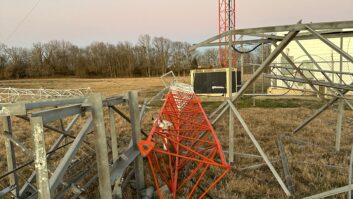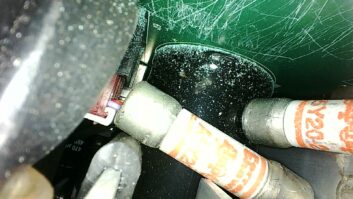Reading about our site security suggestions, Douglas Thompson, DOE for Minnesota Public Radio, writes about an idea he’s used at remote transmitter sites. The solution will not necessarily stop vandals but it may help catch them.
Infrared-controlled snapshot cameras are used to photograph wild game and are sold at hunting and outdoor outlets like Gander Mountain and Cabella’s. These cameras can be mounted in areas where you expect the activity to occur. The cameras are automatic, triggered by movement and IR energy – heat. Most come with a flash, but that feature can be defeated if you want to snap pictures covertly. An IR illuminator can be used to provide a light source without tipping off the vandal, and it provides the equivalent of a monochrome picture.
Their results: they’ve snapped a few pictures of deer, fox and even a cougar – not common in the metro of Minneapolis and Saint Paul! – but no vandals yet. Douglas and his crew have been lucky, but maybe the Houston engineering community could use this method to identify the people responsible for the many break ins at their sites.
Douglas Thompson can be reached at [email protected].
Maybe vandals will think twice if the word gets out that every station is installing these infrared cameras.
Perhaps there is some money – and good will – to be had in this idea for a smart broadcast supplier who adds IR cameras to its line. And buying and installing such cameras might be a good contract engineer project for your client stations. Let me know if you’re successful in marketing this service.
. . .
As you plug and seal openings in the walls of transmitter buildings or coupling networks, keep in mind this tip from “Cowboy” Curt.
(click thumbnail)Fig. 1: Use steel wool and expanding foam to seal cable entries in coupling unit buildings or enclosures.
Curtis Flick provides technical services in the Akron, Ohio, area. Although a can of expanding foam will keep weather – as well as insects and rodents – out of the transmitter building, note that rodents, especially mice, will eat the cured foam.
Unless you lace the foam plug with steel wool, foam alone is not the best way to stop rodents. The foam will stop insects, and the steel wool will stop rodents. See Fig. 1. This tip is also useful in sealing cabling inputs to equipment racks and transmitters.
Curt can be reached at [email protected].

. . .
While clearing off his desk the other day, Dale McCubbins, program director for WCVK(FM) and WJVK(FM) in Kentucky, saw our suggestion about using an old EV mike case to hold a news reporter’s “grab and go” kit. Dale’s stations use an older version of a Walkman MD, so he went to Wal-Mart and purchased a two-pistol carrying case.
For under 10 bucks, there’s room enough for the mike, cables, MD, batteries and even a headset if you want – without any foam trimming. Just make sure you put enough bumper stickers on the case so security officers see it’s not holding a deadly weapon!
(click thumbnail)Fig. 2: Invest in a heavy-duty hand truck for moving remote gear – or heavy jocks!
Dale can be reached at [email protected].

. . .
I’ve written about interesting products that showed up at the recent Bos-Con convention, including a free wiring guide from Clark Wire and Cable offered by Jeff Rosenberg of Modulation Magic.
Bos-Con featured another “find” for any engineer handling remotes. Jim Peck of the Northeast office of SCMS rolled in with the mother of all hand trucks. Meet the Wesco Industrial Products’ Mega-mover. You can view the handtruck at www.wescomfg.com
It’s not cheap, but how many twenty-buck hand trucks have you bought for remote gear over the last couple of years only to have them fall apart? With pneumatic tires and a sturdy welded design, this truck will handle 500 pounds, s seen in Fig. 2.
O.K., I don’t weigh 500 pounds, but the photo shows the rugged design.
The lip of the hand truck is large enough to hold plastic bins or speakers, and the pneumatic wheels make maneuvering easy even with a full load. Fig. 3 shows SCMS reps Matt Cauthen and Jim Peck with the Mega-mover in its folded position.
(click thumbnail)Fig. 3: The Mega Mover Folds up for easy storage.
Contact your SCMS rep ( www.scmsinc.com ) to order.

. . .
Newer high-power transmitters have some sort of three-phase power monitor built in. Usually, the device simply monitors phase loss.
If your three-phase transmitter doesn’t have this kind of monitor, or if you are looking for a means of monitoring your transmitter site’s three-phase voltage, we’ve got a solution for you.
SSAC, probably best known for solid-state tower light flasher modules, has developed the WVM series of microcomputer-controlled three-phase Voltage Monitors. SSAC has packed a lot of features into this little box, which measurs 4-1/2 by 7 inches.
Start with a 10 fault non-volatile memory, 10 amp isolated relay contacts and both a manual or remote reset. Using front-panel rotating pointers, the WVM can be set to select line voltage, phase unbalance, trip delay and restart mode. Obstruction lighting specialists UNIMAR has these monitors available. Reach them at (800) 739-9169 or www.unimar.com
Submissions for this column are encouraged, and qualify for SBE recertification credit.







